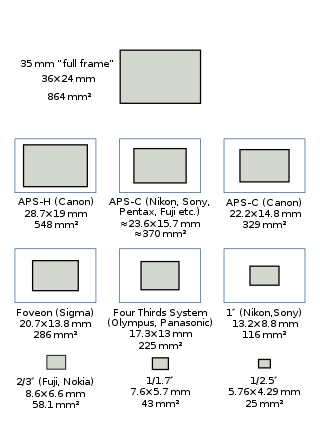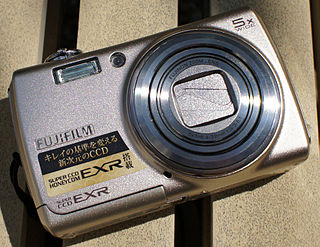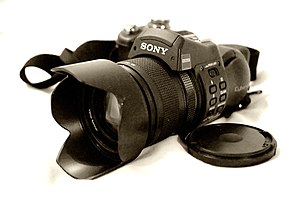
A digital camera is a camera that captures photographs in digital memory. Most cameras produced today are digital, largely replacing those that capture images on photographic film. Digital cameras are now widely incorporated into mobile devices like smartphones with the same or more capabilities and features of dedicated cameras. High-end, high-definition dedicated cameras are still commonly used by professionals and those who desire to take higher-quality photographs.
The Leica Digilux 1 is a digital camera developed in partnership with Panasonic, which was released in 2002, roughly the same time as the Canon PowerShot G2 and the Nikon 2000. It is the second of Leica's digital offerings. Where the original Digilux was developed in partnership with Fuji Camera, the Digilux 1 was developed jointly with Panasonic; Leica is responsible for optics, while Panasonic designs the camera electronics. According to Leica, this allows both companies to design cameras that creates a harmonious matching of lens to sensor to produce color and contrast to Leica standards.

Cyber-shot is Sony's line of point-and-shoot digital cameras introduced in 1996. Cyber-shot model names use a DSC prefix, which is an initialism for "Digital Still Camera". Many Cyber-shot models feature Carl Zeiss trademarked lenses, while others use Sony, or Sony G lenses.

A full-frame DSLR is a digital single-lens reflex camera (DSLR) with a 35 mm image sensor format. Historically, 35 mm was one of the standard film formats, alongside larger ones, such as medium format and large format. The full-frame DSLR is in contrast to full-frame mirrorless interchangeable-lens cameras, and DSLR and mirrorless cameras with smaller sensors, much smaller than a full 35 mm frame. Many digital cameras, both compact and SLR models, use a smaller-than-35 mm frame as it is easier and cheaper to manufacture imaging sensors at a smaller size. Historically, the earliest digital SLR models, such as the Nikon NASA F4 or Kodak DCS 100, also used a smaller sensor.

The FujifilmFinePix F series is a line of compact digital cameras that was known for its low-light performance in 2005, with relatively low image noise and natural colors even at high ISO settings. With its relatively large, but moderate resolution Super CCD sensors, it concentrated on image quality, and low-light shooting without flash, which was mostly restricted to prosumer models at the time.

In digital photography, the RGBE filter is an alternative color filter array to the Bayer filter (GRGB). It similarly uses a mosaic of pixel filters, of red, green, blue and "emerald", and so also requires demosaicing to produce a full-color image. It was developed by Sony and so far is used only in the ICX456 8-megapixel CCD and in the Sony Cyber-shot DSC-F828 camera.

In digital photography, the image sensor format is the shape and size of the image sensor.

The Panasonic Lumix DMC-FZ8 is a 7 megapixel superzoom bridge digital camera made by Panasonic. As with most Panasonic Lumix cameras, it uses a Venus Engine, in this case, the Venus Engine III. It supports the Raw image format and has the same sensor size and zoom level as its predecessor, the Panasonic Lumix DMC-FZ7.
General Imaging was a manufacturer of digital cameras headquartered in Torrance, California, established in 2006 by Hiroshi "Hugh" Komiya, a former executive of Olympus Corporation. General Imaging sold their cameras internationally under the General Electric name, used under license. General Imaging was licensed to manufacture and sell their cameras under the AgfaPhoto name in Japan. On October 5, 2015, General Imaging filed for bankruptcy.

The Canon EOS 50D is a 15.1-megapixel digital single-lens reflex camera. It is part of the Canon EOS line of cameras, succeeding the EOS 40D and preceding the EOS 60D.

The Sony Cybershot DSC-F717 is a bridge digital camera, introduced by Sony in September 2002.
The Sony Cyber-shot DSC-RX100 series is a high-end compact camera part of the wider Sony RX series. It started with the DSC-RX100, announced on 6 June 2012, and is part of the Cyber-shot RX line of digital cameras made by Sony. Seven annual generations have been released so far until 2019, all equipped with a one-inch 20-Megapixel image sensor and rotary knob around the lens. Filming at up to 1080p at 60fps is supported by the first three generations, the third additionally with 720p at 120fps, and up to 2160p (4K) at 30fps and 1080p at 120fps high frame rate video since the fourth.

The Sony Cyber-shot DSC-RX1 is a series of premium fixed-lens full-frame digital compact cameras made by Sony as part of its Cyber-shot line.

The Sony Cyber-shot DSC-HX200V is a hyperzoom bridge digital camera that features:

The Sony Cyber-shot DSC-HX400V is a hyperzoom bridge digital camera that features:
The Sony Cyber-shot DSC-QX30 is an ultrazoom, mobile device-mountable, lens-type compact camera manufactured by Sony. Announced on September 3, 2014, the QX30 is one of Sony's "Smart Lens" cameras, alongside the QX1, QX10 and QX100, that are designed to be specifically used with a smartphone. It has a 1/2.3 inch backside-illuminated Exmor R™ CMOS sensor with 20.4 effective megapixels, sitting behind an ƒ/3.5 (wide) to ƒ/6.3 (telephoto) Sony G Lens. Its highlight feature is its 30x lossless optical zoom.

The Sony Cyber-shot DSC-HX90V is a digital zoom compact camera, which can zoom up to 30x; equivalent to 24-720mm. At the time of its release, it is the world's smallest superzoom camera. It features optical image stabilization, an AF Illuminator, an 18.2MP BSI Active pixel sensor and has customisable settings. The camera has a pop-up OLED electronic viewfinder that has 638,400 dots and is far brighter than any other conventional electronic viewfinders. The camera’s screen is a 3" TFT LCD that tilts upward 180 degrees. Also borrowed from the RX100 is a customizable ring around the front of the lens. The HX90V can record video at 1080/60p using the XAVC S codec, which allows for bit rates up to 50MBps. The camera has a built-in GPS; used for geotagging. The camera also has built-in Wi-Fi with NFC and Bluetooth, which means you can connect your camera to your phone or tablet by using PlayMemories Camera Apps.

The Sony RX is the name of a range of fixed lens compact point-and-shoot digital cameras created by Sony in 2012. All cameras are equipped with Carl Zeiss lenses.

The Sony Cyber-shot DSC-QX100 is a mobile device-mountable lens-type compact camera manufactured by Sony. Announced on September 3, 2014, the QX100 is one of Sony's "Smart Lens" cameras, alongside the QX1, QX10 and QX30, that are specifically designed to be used with a smartphone. Its highlight features are its 1-inch backside-illuminated Exmor R CMOS sensor taken straight from the Sony RX100 II premium compact camera, with 20.2 megapixels, ƒ/1.8 to ƒ/4.9 Carl ZEISS® Vario-Sonnar T* lens and a 3.6x (28–100 mm) optical zoom.















